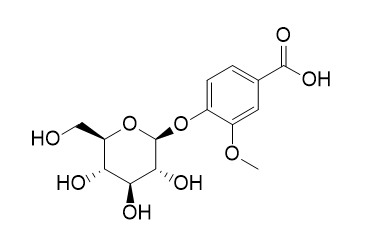Vanillic acid glucoside
Reference standards.
Inquire / Order:
manager@chemfaces.com
Technical Inquiries:
service@chemfaces.com
Tel:
+86-27-84237783
Fax:
+86-27-84254680
Address:
1 Building, No. 83, CheCheng Rd., Wuhan Economic and Technological Development Zone, Wuhan, Hubei 430056, PRC
Providing storage is as stated on the product vial and the vial is kept tightly sealed, the product can be stored for up to
24 months(2-8C).
Wherever possible, you should prepare and use solutions on the same day. However, if you need to make up stock solutions in advance, we recommend that you store the solution as aliquots in tightly sealed vials at -20C. Generally, these will be useable for up to two weeks. Before use, and prior to opening the vial we recommend that you allow your product to equilibrate to room temperature for at least 1 hour.
Need more advice on solubility, usage and handling? Please email to: service@chemfaces.com
The packaging of the product may have turned upside down during transportation, resulting in the natural compounds adhering to the neck or cap of the vial. take the vial out of its packaging and gently shake to let the compounds fall to the bottom of the vial. for liquid products, centrifuge at 200-500 RPM to gather the liquid at the bottom of the vial. try to avoid loss or contamination during handling.
BMC Complement Altern Med.2017, 17(1):384
Int J Mol Sci.2022, 23(23):15213.
Toxicol In Vitro.2023, 86:105521.
Molecules.2023, 28(5):2376.
Plants (Basel).2024, 13(6):868.
Natural Product Communications2021, 16(9):1-10.
SCOPUS.2020, 836-847.
Int Immunopharmacol.2023, 123:110572.
Clin Exp Pharmacol Physiol.2020, doi: 10.1111
J Chromatogr Sci.2015, 53(5):824-9
Related and Featured Products
Journal of Food Measurement & Characterization, 2018,29(5)808–819.
HPLC-ESI-MS/MS characterization of phenolics in prunus amygdalus, cultivar “umm alfahm” and its antioxidant and hepatoprotective activity.[Reference:
WebLink]
METHODS AND RESULTS:
Metabolite profiling of the total ethanolic extract of Prunus amygdalus stem and leaves was carried out for the first time using LC-DAD-ESI-MS in the negative ion mode to investigate its chemical composition. Results revealed the identification of 33 phenolic compounds.
Fifteen compounds were investigated in P. amygdalus for the first time and identified as; veratic acid, rosmarinicacid, protocatechuic acid-hexoside, 3-O-caffeoylquinic acid (neochlorogenic acid), dihydroquercetin- hexoside, coumaroyl-quinic acid, Vanillic acid glucoside, cis piceid, hesperidin, dihydrokaempferol, acteoside, quercetin acetyl hexoside, homovanillic acid, fisetin-deoxyhexoside. The antioxidant potential of the total ethanolic extract (EE) and the fractions: petroleum ether (PE), chloroform (CE), ethyl acetate (EtE), methanol eluted diaion (DME) and diaion eluted with 50% methanol (D 50%E) was performed using DPPH assay. The most potent antioxidant EE, EtE and D50%E extracts (compared with vitamin C) were selected for further hepatoprotective assessment against hepatotoxicity induced by thioacetamide in a dose of 200 mg/kg compared with silymarin (50 mg/kg) as a standard drug.
CONCLUSIONS:
Results revealed the significant reversal of the deleterious effects of thioacetamide on serum ALT, AST and total protein in the order: EtE > (Silymarin = EE) > D50% E. The biochemical results were corroborated with the histological studies of liver.



